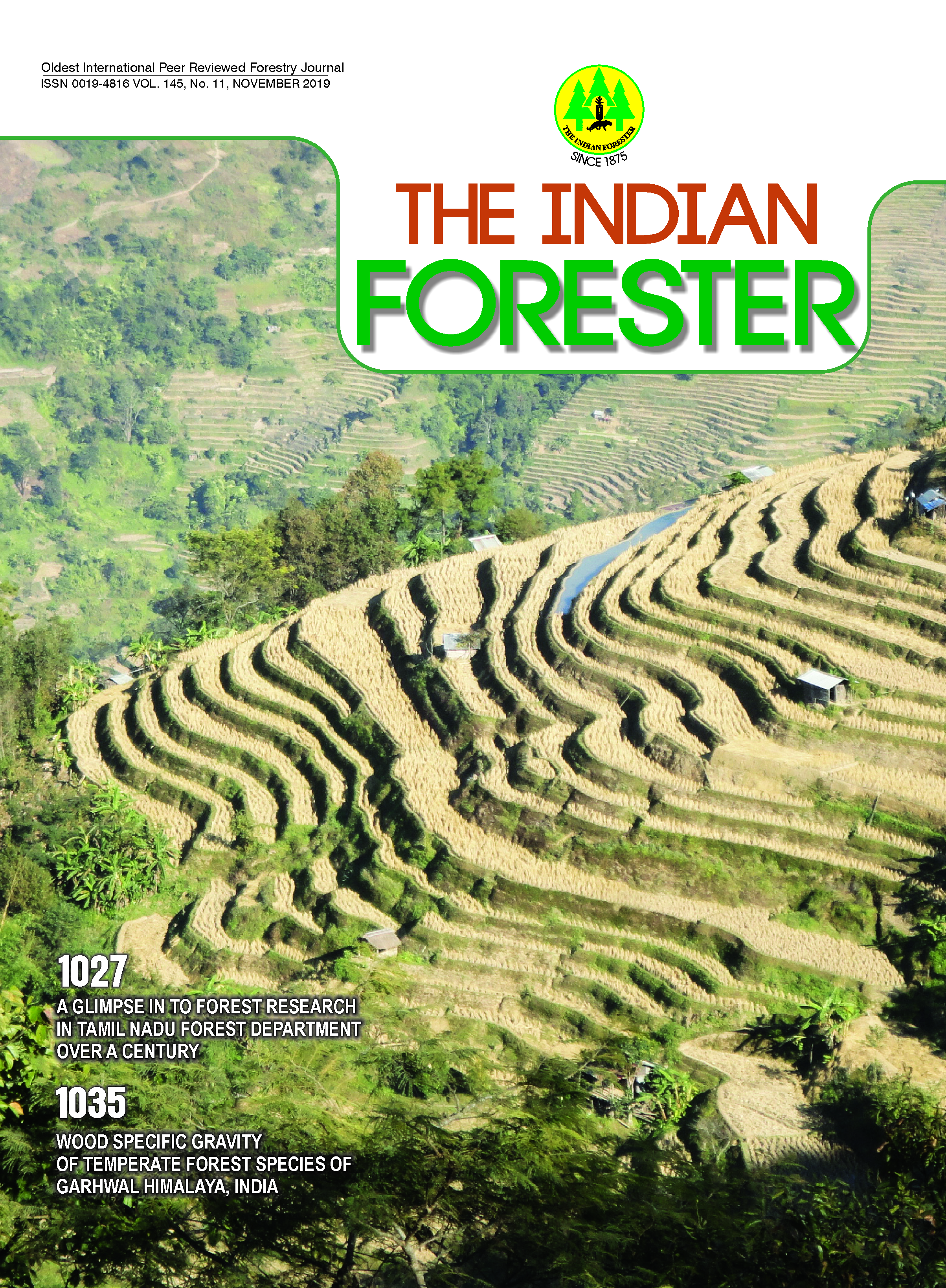Estimation of Biomass, Nutrient Content in Grasses and Soil at Different Elevations in Langate Forest Division, Kashmir Himalaya, India
DOI:
https://doi.org/10.36808/if/2019/v145i11/149919Keywords:
Above Ground Biomass, Nutrient Analysis, Dominant Grasses.Abstract
The aboveground biomass of different grasses present at different elevations revealed that the maximum production was at higher elevation (2500-3000m) followed by middle (2000-2500m) and lower elevation (1500- 2000m) with maximum contribution from, Poa pratens is at higher elevation followed by Chrysopogon echinulatus at middle elevation and Cynodon dactylon at lower elevation. The nutrient content of different dominant grasses present at the sites/elevations revealed that the nitrogen (N), phosphorus (P), potassium (K), Crude Protein (CP) of dominant grass species at different elevations of the Rajwar Range of Langate Forest Division increased from lower to middle elevation and was highest for upper elevation while in case of calcium (Ca) and Magnesium (Mg) it showed a declining trend from lower to middle and was lowest in upper elevation. The chemical properties of soil contents [Nitrogen (N), Phosphorus (P), Potassium (K)] of different locations/elevations in Rajwar Range of Langate Forest Division increased with the increase in elevation and were maximum for upper elevation followed by middle elevation and lowest in lower elevation.References
Aggarwal S.K., Saxena N. and Kaul P. (1978). Herbage production and nutrient composition of grasses in arid grasslands as related to season and rainfall: Cenchrusciliaris and Cenchrussetigerus grass species, Forage Research, 4: 149-157.
Anitha K., Joseph S., John C.R., Ramasamy E.V. and Prasad S.N. (2010). Tree species diversity and community composition in a human-dominated tropical forest of Western Ghats biodiversity hotspot, India. Ecological Complexity, 7: 217–224.
Brant V., Pivec J., Venclová V., Soukup J. and Holec J. (2006). The Influence of different Soil Vegetation Covers onto the Volumetric Water Content in Upper Soil Layers. Plant Soil Environ., 52(6): 275–281.
Chawla S., Rajkumar K.N., Singh B. Lal, Thukral A.K. and Singh R.D. (2008). Plant species diversity along an altitudinal gradient of Bhabha Valley in western Himalaya, Journal of Mountain Science, 5 (2): 157–177.
Ingham E.R., Trofymow J.A., Ames R.N., Hunt H.W., Morley C.R., Moore J.C. and Coleman D. C. (1986). Trophic interactions and nitrogen cycling in a semiarid grassland soil: part I seasonal dynamics of the soil food web. J. Appl. Ecol., 23: 608-615.
Jamieson T., Gordon R., Cochrane L. and Patterson G. (2002). Fundamental Aspects of Soil-Water-Plant Relationships. Resource Stewardship Division, N.S. Department of Agriculture and Fisheries-Truro, Nova Scotia.
Jones Jr., J.B., B. Wolf, and H.A. Mills. (1991). Plant analysis handbook. Micro-Macro Publishing Inc., Athens, GA, USA.
Kala C.P. and Mathur V.B. (2002). Patterns of plant species distribution in the Trans-Himalayan region of Ladakh, India. Journal of Vegetation Science, 13(6): 751–754.
Marx J., Bary A., Jackson S., McDonald D. and Wescott H. (1999). The Relationship between Soil and Water-How Soil Amendments and Compost Can Aid in Salmon Recovery. Online.
Melkania, N.P. and Singh, J.S (1989). Ecology of Indian grasslands. In: Perspective in Ecology (ed. J.S Singh and B. Gopal), Jagmonder Book Agency, New Delhi.
Merwin H.D. and Peech M. (1951). Exchangeability of soil potassium in sand, silt and clay fraction as influenced by the nature of complementary exchangeable cations. Soil Science Society Am. Proc. 15 : 125-128.
Misri B. (1988). Forage production in alpine and sub- alpine regions of north western Himalaya. In: P. Singh (Ed.) Pasture and Forage Crop Research- a state of knowledge report. RMSI Jhansi : 43-55.
Olsen S.R., Cole, C.V., Watanabe F.S. and Dean L.A. (1954). Estimation of available phosphorus in soils by extraction with sodium bicarbonate. USDA circular 939. U.S. Govt. Printing Office, Washington, D.C.
Oommen M.A. and Shanker K. (2005). Elevational species richness patterns emerge from multiple local mechanisms in Himalayan woody plants. Ecology, 86 (11): 3039–3047.
Puglisi E., DelRe A.A.M., Rao M.A. and Gianfreda L. (2006). Development and validation of numerical indexes integrating enzyme activities of soils. Soil Biol. Biochem., 38: 1673-1681.
Rodriguez-Iturbe I. (2000). Ecohydrology: A Hydrologic Perspective of Climate-Soil-Vegetation Dynamics. Water Resources Research, 36(1):3–9.
Rozhkov V.A. and Karpachevskii, L. O. (2006). The forest cover of Russia and soil Conservation. Eurasian Soil Science, 39(10): 1041-1048.
Sankaram A. (1966). A laboratory manual for agricultural chemistry. Madras : Asia Publishing House, 252-263.
Singh J.S. (2006). Sustainable development of the Indian Himalayan region: linking ecological and economic concerns, Current Science, 90(6): 784–788.
Subbiah B.W and Asija G.L. (1956). A rapid procedure for the estimation of available nitrogen in soil. Current Science 25(9): 256-260.
Uma Shankar. (2001). A case of high tree diversity in a Sal (Shorearobusta) - dominated lowland forest of Eastern Himalaya: Floristic composition, regeneration and conservation. Current Science, 81: 776-786.
Xu Q.F., Jiang P.K. and Xu Z.H. (2008). Soil microbial functional diversity under intensively managed bamboo plantations in Southern China. J. Soil sediments., 8: 177-183.
Downloads
Downloads
Published
How to Cite
Issue
Section
License
Unless otherwise stated, copyright or similar rights in all materials presented on the site, including graphical images, are owned by Indian Forester.





